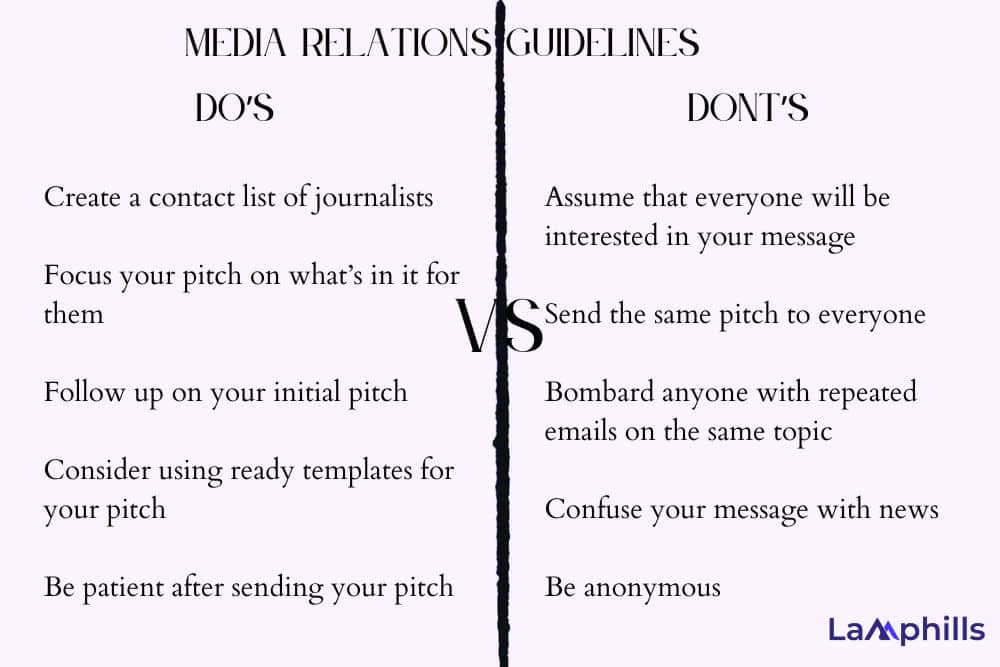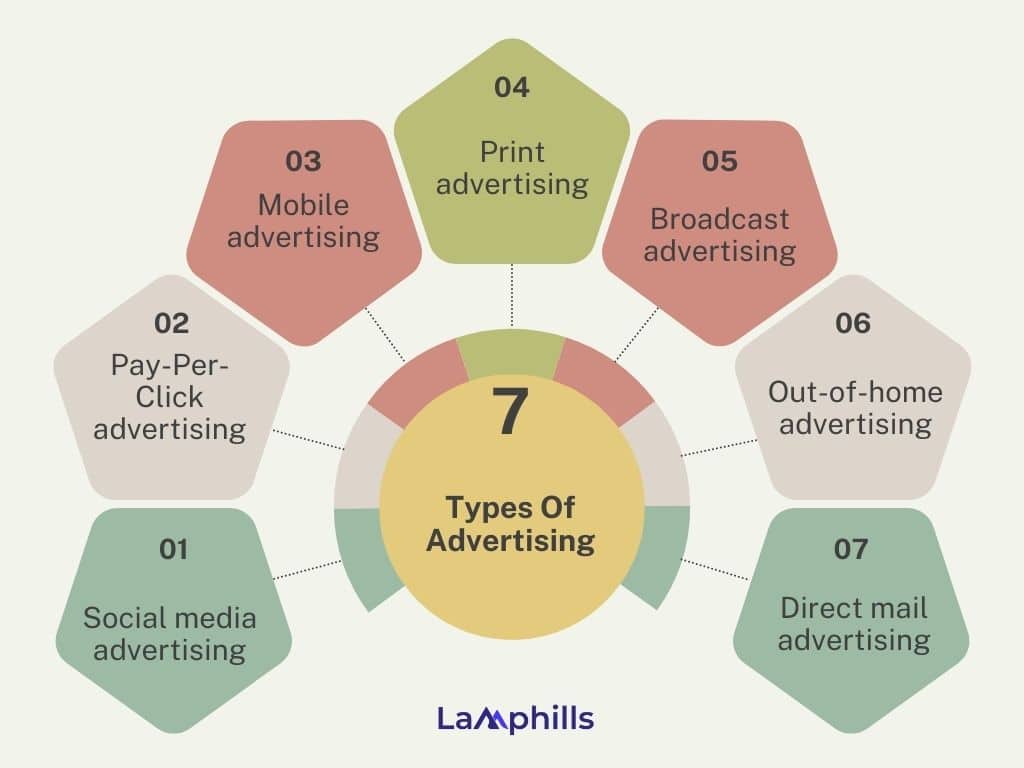When it comes to PR vs. advertising, there are several key differences. These are captured in numerous sayings like ‘advertising pays, public relations persuades’ and “advertising is what you pay for, publicity is what you pray for”, among others.
The primary motive of any business is profit maximization, which can only be achieved by increasing sales. This leads to the application of strategies, tactics, tools, and plans to gain maximum customer attention and grab a competitive position in the market. All of these fall under the promotion mix, which has four aspects: advertising, direct selling, sales promotion, and public relations.
In this case, advertising alludes to any form of communication that a firm uses to instigate prospective customers to choose the product offered by the company, over other products. On the other hand, public relations is about building and maintaining good relations, with the company’s stakeholders, by gaining favorable publicity, having a good reputation and so on.
Advertising and Public Relations usually go hand-in-hand when used by companies as part of their marketing strategy to achieve their business goals. However, both are, in fact, two different practices.
PR vs. Advertising: Key Takeaways
- An established PR strategy defines every way in which a company positions itself on the global stage and communicates with all the stakeholders.
- Companies use advertising to share information about their products or services through various media.
- Both advertising and PR share the same goals, in that their aim is to convey a particular message to their chosen audience.
- The difference is who controls the message and what the content looks like.
- One of the biggest differences when comparing PR vs advertising is the credibility and believability of the two promotional avenues.
- The cost difference between the two disciplines is dependent on numerous factors, but typically, advertising costs dwarf those of PR campaigns.
PR vs. Advertising: What is PR?
Public relations is the process of establishing strategic communication relationships across different media channels to promote the positive perception of your company with the relevant audiences and get additional coverage from those channels.
An established PR strategy defines every way in which a company positions itself on the global stage and communicates with all the stakeholders. These are your current and prospective customers, journalists, influencers, and anyone else who’s important to your organization. These help a company organize its public relations efforts to attract its target audience and identify ways to reach its goals during the planning stage. They’re similar to marketing strategies because the primary goal is to spread brand awareness.
Businesses often rely on outlets, such as media sources, blogs, social media or podcasts, to help them deliver messages for these strategies to a wider audience. PR professionals group these into three categories, which are:
- Owned media: This includes any outlets a company owns and operates, such as a blog, social media sites, or video channels.
- Earned media: This refers to any content a third party creates about a brand or company without being paid to do so, such as online reviews, social media posts, or word-of-mouth recommendations
- Paid media: This is any type of media a company pays for to increase its reach or exposure, such as advertisements, sponsored posts, or influencer content.
Public relations strategies also can be useful in crisis management situations because they allow organizations to respond to a negative situation and try to develop a possible outcome from it. A good strategy can help companies increase their reputation if they overcome a negative situation.
PR vs. Advertising: Elements of PR
Public relations teams serve many different purposes and there are various types of PR activities, each addressing its own specific goals. These are the checkpoints for your public relations roadmap, the most important elements of the basic PR plan you need to keep in mind while you’re trying to figure out how to do digital PR.
#1. Media Relations
Chances are, this is exactly what you’re thinking about when hearing the term “public relations”. And yet, media relations management is just one of the main stepping stones on your way toward a proper PR strategy.
Here, your main goal is to build positive relations with bloggers, journalists, and influencers to get yourself media coverage for free (or close enough to it). It’s always good to have someone who speaks to large audiences on your behalf, and that’s exactly what media relations are all about.
In the digital era, establishing and maintaining media relations for PR purposes mainly involves writing press releases and other communications, pitching the media, organizing and participating in different interviews, attending special events, etc.

#2. Crisis Management
Life happens, and that means unforeseen problems will show up in your office one day. When a crisis hits and things are moving at the speed of the internet, managing and, if needed, correcting the impressions that are created is hard.
That’s when you need a good PR specialist right there in the eye of the storm ready to back your business up with some bulletproof crisis management techniques, contacts to help get your message out in a hurry, and the ability to steer the conversation in the direction you want.
While there’s no way to be prepared for everything that gets thrown at you, the point is that your PR team is appointed as the go-to leaders in dealing with managing a crisis. When the problem hits and your reputation is on the line, there’s no time for meetings to decide who’s going to be in charge of your response — your PR should be ready to go to work in difficult circumstances at a moment’s notice.
#3. Marketing & Communications
It’s pretty easy to forget about other important forms of communication while you’re searching for the most effective ways to do digital PR, like traditional marketing. Chances are, your business is already engaged in numerous marketing campaigns, so it’s your job to make sure those are well-managed as well.
When talking about public relations, a particularly essential aspect of marketing is social media. In a way, this is the easiest way for you to talk directly to all the stakeholders. So make sure to apply each of the basic PR plan principles discussed above to your SM strategy as well. Reply to comments and reviews (especially the negative ones), engage in online social movements and challenges, and collaborate with other brands from your area to improve community relations.
Also, don’t be afraid to try new things!
Every touchpoint where your brand gets a chance for exposure is another opportunity to shape opinions on what you’re all about. But most importantly, make sure your marketing and PR teams are on the same page. Pulling in opposite directions will get you nowhere.
#4. Employee Relations
When you’re learning how to do digital PR, it’s easy to fall into the novice error and focus on the clients and the clients alone. In reality, public relations are much more complicated than that. For starters, you need to make sure that your PR plan never omits your own employees, both current and potential ones.
Think of it as internal PR.
First of all, your very own staff might be the strongest team of brand ambassadors you’ll ever need. At the same time, an unhappy employee is very likely to spread the harshest criticism. That’s why companies must invest in employer branding and internal PR & communications to ensure your team members feel appreciated, heard, and respected.
#5. Community Management
Another important audience to keep in mind to help you do PR like a pro is your local community. After all, if you own an offline business, you’d most probably like to have a community spirit around it. That’s exactly what this type of PR is all about.
With community management, you ensure to communicate where your business stands on some of the crucial local issues, how it is perceived by the neighbors, and whether it makes a social commitment or not. In the long run, investing in positive community relations can provide you with new loyal brand ambassadors, a strong boost in your company’s ethical reputation, more future recruits, and more.
Here, it’s not enough to say what your company’s behind – you need to really show it. Make sure you participate in local events sharing your expertise and time or at least donating some profits towards a worthy cause.
Highlight your good deeds online (having ongoing relations with the media from the previous point wouldn’t hurt here as well). Organize community events, and don’t be afraid to stand up for your ideas.
Proactive vs Reactive PR
Public relations is a steady mix of being proactive while also being reactive.
The proactive elements refer to staying on top of trends, anticipating questions from the media, and proactively seeking opportunities for clients that put them in a good light. These include writing press releases, pitching to media outlets, or securing coverage in a trade publication. Proactive PR helps you build valuable relationships with the media and build on your brand’s image.
Reactive PR is also necessary to respond to external events, such as the news, a trending topic, or a crisis. These events provide the opportunity to be seen as relevant and knowledgeable. They can help you identify opportunities to insert your brand into the conversation and build on approaches for future strategies. You can then get the most out of your efforts by combining both.
For example, proactive efforts can get your ideas and thought leadership content published. You can leverage this to solidify your position in the market.
PR vs. Advertising: How To Do PR Like A Pro
In today’s competitive marketing landscape, having a comprehensive PR strategy is essential for establishing a positive company image, connecting with your target audience, and standing out in the market.
Follow these 13 effective PR strategies to elevate your brand’s reputation, build trust, and achieve long-term success:
Best PR Strategies
PR vs. Advertising: Common PR Campaign Objectives
Public relations is a powerful way to connect with your audience and creating the ideal campaign and implementing it properly, has never been more important.
The goal of a public relations campaign is to create a media narrative and control the spread of information about your business to attract customers. It can also be used as a tactic to generate awareness about a specific event or business venture. Most times, marketing and advertising campaigns are focused on driving sales, whereas public relations teams usually have set different PR KPIs:
- Attract media attention
- Generate awareness
- Inform the public about the latest company news
- Enhance your brand reputation
- Build stakeholder relations
Many PR experts choose to use the SMART method as a template when coming up with the goals for their PR campaign:
- Specific: What is the desired outcome?
- Measurable: How will success be measured?
- Achievable: How will the campaign achieve its goals considering outside influences?
- Realistic: Is your campaign goal realistic for the bandwidth of your campaign?
- Time-based: How long do you have to meet these goals?
PR vs. Advertising: What Is Advertising?
Companies use advertising to share information about their products or services through various media. The advertising landscape has changed with technology, with print and broadcast advertising serving as the traditional format and digital advertising serving as a more modern option.
With technology, companies gain new ways of targeting consumers and tracking the effectiveness of their advertising campaigns.
PR vs. Advertising: Types Of Advertising
Companies can use various advertisements to reach their target consumers or to inform the public. Here are the most common types of advertising and examples:

Social media advertising is a popular choice for small businesses because the cost is relatively affordable and you can be highly selective with the audience you target. For example, if you own a retail store, you can use ad targeting options to narrow the audience so that only people of a certain demographic living within a certain mile radius of your store are served your social ads.
#2. Pay-Per-Click Advertising
Pay-per-click (PPC) advertising is a type of online advertising where advertisers pay a fee every time a user clicks on one of their ads, usually through a search engine. Advertisers bid on ad placements within the search engine, meaning they set a maximum price they’re willing to pay for a user to click on their ads. If a person sees your ad but doesn’t click on it, you aren’t charged anything.
The most common platforms for PPC advertising are Google Ads and Bing Ads. PPC advertising is a form of search engine marketing (SEM). It can be a great option for small businesses with limited budgets and according to WordStream, businesses make $2 in revenue on average for every $1 they spend on Google Ads.
#3. Mobile Advertising
Mobile advertising is a type of digital advertising in which ads are served only on mobile devices, including smartphones and tablets. It can include:
- Mobile display ads
- Mobile search ads
- Mobile videos
- Mobile app ads, which are meant to drive downloads of a brand’s app
- Social media ads served on mobile devices only
Having a mobile advertising strategy can pay off for your small business. Eighty-four percent of adult customers under the age of 30 are most likely to shop online using a mobile device.
#4. Print Advertising
Print advertising used to be the primary advertising method for small businesses before the advent of digital advertising. Now, print ad revenues are shrinking and as a small business owner, you may find the cost is much higher than the cost of digital and social advertising. It’s also more difficult to measure the success of your print advertising campaigns since it’s almost impossible to prove how many people who saw your ads in print went on to make a purchase at your store or become a client of your business.
However, for some local businesses or businesses that target older, less digitally engaged audiences, print advertising can still be a good choice for your ad spend. Print advertising includes newspaper ads, magazine ads, and ads in brochures and flyers.
#5. Broadcast Advertising
Broadcast advertising includes mass-market media like TV and radio. While broadcast advertising, especially TV ads, can be cost-prohibitive for small businesses, if you have local TV and radio stations near you, the cost might be more affordable and the audience could be highly relevant to your local business.
The cost of broadcast ads depends on several factors, including the length of the ads (longer TV and radio ads will cost more to air), the frequency they play, and the time of day they’re aired. You’ll also need to factor in the cost of producing the ads since professional TV ads can be quite expensive to produce.
#6. Out-Of-Home Advertising
Out-of-home or outdoor advertising refers to any advertising that reaches people when they’re outside of their homes. This includes billboard ads, digital signage, transit ads (i.e. bus shelters, train ads, subway stop ads, etc.), street furniture ads, and ads in sports venues. Out-of-home advertising can be quite expensive, so be sure it fits with your advertising budget.
#7. Direct Mail Advertising
Direct mail advertising involves all forms of ads that are delivered to a person’s home through the mail. This includes brochures, catalogs, sales letters, and newsletters.
While direct mail is a less popular advertising method for small businesses than digital advertising, it can be successful if you develop a creative, visually appealing direct mail campaign. Direct mail ads enable you to deliver your message one-on-one to local consumers.
PR vs. Advertising: Advertising Strategies
There are many possible advertising strategies, as each brand’s situation, identity, and objectives are unique. To get an idea of the possibilities, let’s take a look at the 3 major types of advertising strategies.
#1. Content Advertising
This advertising strategy seeks to directly influence consumers through different channels with a direct, clear message that aims to reach as many people as possible. Although it is similar to content marketing, it is not the same since it is more direct and more focused on the brand.
Within content advertising, we can distinguish the following different subtypes:
- Informative advertising: this focuses on showing the brand and the value it can bring to potential customers. It is usually based on rational values.
- Comparative advertising: this focuses on comparing a brand with the competition to reinforce the characteristics that differentiate it and convince the consumer that it can provide greater benefits. Although this can be very effective, you must be very careful when making your claims in order not to run into legal problems.
- Emotional advertising: if informative advertising is based more on rational factors, emotional advertising seeks to get an emotional reaction. It can be very effective in influencing purchasing decisions since we know that these have a strong subconscious component that is based on how people feel about a product or service.
#2. Pull Advertising
This advertising strategy is typical of brands that are already well-known and well-positioned in the market. Instead of going after customers, this strategy aims to keep a brand in the consumer’s mind and propel people towards it. It focuses on identification with the brand and long-term loyalty.
#3. Push Advertising
This advertising strategy is more suitable for new products or services since it seeks to make something known among consumers to position well and generate sales.
The push strategy can use different channels, from traditional media to social ads. In many cases, it goes hand in hand with pricing strategies. For example, offering cheaper launch prices to generate an initial critical mass of consumers.
It is also common for push advertising to be done in tandem with content marketing so that a new brand can establish its authority early on and position itself as an expert in its sector.
Here are some of the most widely used and effective advertising strategies, according to PPCExpo and other experts in marketing and advertising.
Advertising Strategies
PR vs. Advertising: Differences
PR vs. Advertising: Goal
Both advertising and PR share the same goals, in that their aim is to convey a particular message to their chosen audience. The difference is who controls the message and what the content looks like.
When it comes to advertising, companies ultimately have complete control over every aspect relating to the advert. That includes the message of the advert, the creative element, as well as the channels that will be used to promote the advert, essentially when and where the audience will be shown the content.
Companies are given free rein to showcase how great they are and indulge in as much self-promotion as possible with very little regulation, depending on the industry, providing said content is not offensive or harmful.
In contrast, PR is a discipline where a company that is keen to obtain media coverage has control over the channels they aim to seek coverage but does not control the message itself. Once a story is sent to a journalist, the journalist will rewrite and have creative license over the linguistic and visual choices of the content. With journalists having to adhere to guidelines and principles, it is their responsibility to present content in a certain manner.
However, this lends more credibility to the brand obtaining media coverage, as the coverage is typically presented in an informative, unbiased manner as opposed to the more biased content associated with advertising.
Credibility of PR vs Advertising
One of the biggest differences when comparing advertising with PR is the credibility and believability of the two promotional avenues. The credibility that a piece of media coverage brings far outweighs that of an advertisement, for a number of reasons.
Advertisement is paid media, public relations is earned media. In effect, an advert expresses that “we offer the best service in the market”, whereas PR is a third-party endorsement informing the audience that “they offer the best services.”
A Nielsen study, taking a deeper look at the role of content in the consumer decision-making process concluded that PR is roughly ‘three times more effective than advertising.’

This is because, whereas advertising reflects the company’s view that a potential consumer should possess an interest in their product or service because of how wonderful it is, PR takes a more balanced approach, often engaging in effective storytelling to present a problem, or gap in the market, and how the brand covered in the publication presents a unique solution.
It can come about after a media request as the journalist wants to write a story about your sector or niche.
PR vs. Advertising: Difference in campaign cost
The cost difference between the two disciplines is dependent on numerous factors, but typically, advertising costs dwarf those of PR campaigns. Advertisements are media that you pay for, for a certain time. An example would be a Facebook Ad campaign that has a set budget and timeframe allocated to it. Once the budget has gone, the ad will stop running.
If you choose to advertise in a newspaper, this would include the cost of creative design and duration, so could be very costly. Typically, most advertisements need to be shown to their intended audience quite a few times before the consumer takes notice and is influenced by the content.
In contrast, media coverage obtained through PR campaigns is typically published once, and not re-used like advertisements. However, with the help of social media, the positive effects that come with visually compelling press coverage can be built upon when shared and published strategically on numerous social media platforms.
The PR can also be shared in email campaigns and in newsletters.
PR is often viewed as being complicated and also expensive for a small business, so many choose to use their budget on marketing campaigns. In reality, the reverse is true. PR is easier and cheaper than advertising, and much more effective. This is why the best businesses make full use of it as part of their overall marketing plan.
PR vs. Advertising: Importance of PR Strategies

#1. Cement Trust in Your Brand
Your strategy will dictate how your brand approaches public debates and discussions trending within your industry.
Thought leadership is an excellent example of this, as a name and a face get attached to your brand, making the brand more human. You will gain the trust of your target audience, who will start seeing the potential of your work and values.
The more you speak up, leaning on your expertise and industry knowledge, the more likely it is to build credibility and authority within your industry.
#2. Generate Leads and Sales
Generating income is typically a focus of the marketing team. However, launching a PR campaign will inevitably contribute to increased interest in your brand. Ideally, a PR campaign will generate more publicity, sales, or leads.
#3. Boost Brand Awareness
This is one of the most important aspects of a PR strategy. Brand awareness emerges (positive or negative) as the public starts to recognize and learn about your brand, its values, and how the organization contributes to innovation within its industry.
#4. Crisis Management
A solid PR strategy foresees potential dangers to your image. Adverse events can always happen. It’s wise to be prepared to tackle those situations, which is exactly what a PR strategy can help with. Preparing for such an eventuality and creating effective statements and messaging to combat this is an essential practice.
While it is not possible to eliminate the possibility of negative PR, it is possible to prepare for counter-action should it occur.
#5. Media Relations
Launching a PR campaign means engaging with journalists and media outlets. This way, it is more appealing to the outlets that matter the most, and it increases your chances of forming a long-term relationship with that journalist that will benefit both of you in the future.
#6. Attract Investors
Having a thought-out PR strategy will ensure that your brand gets the timing right to get the most attention paid to what you want to share. Whether it’s a milestone, a successful funding round, a breakthrough, an innovation, an idea, or just a story of your brand, the more attention and better timing you have, the more investors will likely be attracted to your brand.
This can secure the trust of people who see the potential of your product or service.
#7. Grab the Attention of the Experts
Industry experts will be watching your successes and mistakes. The strategy you use can work in your favor by ensuring that the experts become advocates, especially those who are attracted to your business and who resonate with your values, beliefs, and ideas.
This can prove invaluable but requires a PR strategy that provides the best timing and positioning.
#8. Measure Your Success
You will need specific measurements and metrics in place throughout your campaign to know how well you’re doing and to get an overall measure of the success of your campaign.
Therefore, a PR strategy is necessary to establish this criterion and have a clear and concise overview of your campaign’s main objectives and secondary goals and aims. Often, it is important to use media monitoring tools to keep track of statistics relating to your online presence, activity, and web traffic from target audiences.
PR vs. Advertising: Importance Of Advertising
Advertising is an important part of trade and commerce for multiple reasons, including:
#1. Increases Sales
Advertising’s main goal is to increase the number of people who buy your product. You can achieve this by using advertisements to persuade customers that your product is high-quality, useful or desirable. An effective advertisement can convince customers to purchase your product, which may dramatically improve your overall sales.
#2. Informs Customers
Creating an advertisement is a simple way to inform potential customers of your product and any advantages or features it may have. You can include important information such as the function of a product, where you can buy it, price, and unique qualities in a short period. Advertising also allows you to tell your audience about promotions such as sales, special services for new customers, or special events.
When your company introduces a new product or service, you can create an ad to inform your customers about it. This allows you to show the new product to a large number of people and create an interest in the release. Telling a larger amount of people about your product release may increase the number of people who want to buy it.
#3. Retains Customers
Using advertising can help remind your customers about your brand and may encourage them to continue buying your product. A customer who once used your product may see an advertisement and remember their positive experience. This can motivate them to purchase that product again or try other services from your company.
#4. Differentiates Your Brand & Increases Customer Trust
Because most products and services have multiple companies competing for customers, your company may need to find ways to distinguish itself from competitors. Advertising elements such as logos, color schemes, fonts and taglines are ways to establish a brand identity and create a difference between your product and other companies. If a customer recognizes or likes your brand design, that may increase the chances of them purchasing your product.
This can increase familiarity and trust between you and your customers. If a potential customer sees multiple ads about your product, they may consider you a trusted brand. You can also use advertising to address any concerns, which further builds trust between your company and your customers.
#5. Reaches Target Customers
Using advertising can help you easily identify or market toward a particular target audience. After researching a target audience, you can release an ad that may appeal to them at locations they usually frequent. If you have more than one target audience, you can create separate ads and market to both audiences in different areas.
#6. Explains Company Values
A company with powerful, visible values can resonate with customers and may encourage brand loyalty. Advertisement allows you to describe your company’s core traits or values to a wide audience and may encourage them to try your product. Having clear company values can also increase customer trust and may strengthen a brand’s identity.
What LampHills Will Do For You
While all public relations efforts are dedicated to creating and supporting the positive image of your company, there are many additional objectives you can pursue with a well-developed PR strategy.
Among all the benefits a good PR plan can bring to your business, there are certain key functions of public relations you need to be aware of. In particular, a strong public relations strategy should help you to:
- Learn and react to a particular audience’s opinion about your brand
- Actively implement strategies that improve your brand image
- Seek and maintain positive relationships with investors, journalists, clients, etc.
- Manage your online presence and the appearance of your business
- Promote your company across various media channels
- Mitigate the impact of a crisis on your brand’s reputation
Founded on the principles of transparency, creativity, and strategic insight, LampHills is your go-to if you’re seeking to enhance your public image and media relations. Armed with a team of seasoned experts, they are committed to guiding you through every step of your PR journey. They will ensure that your message not only reaches but also positively impacts your target audience.
LampHills reshapes reputations and builds lasting legacies. And with a blend of strategic expertise and creativity, they create compelling narratives that elevate your brand and leave a lasting impact. This PR agency prides itself on its unwavering commitment to delivering exceptional results while ensuring a collaborative environment that allows ideas to flourish and your reputation and legacy to thrive. We are just a click away.
Recommended Articles
- PR Tools: Our Best 15 Picks for 2024 (Free & Paid)
- How to Send a Press Release to Local Media (+ Expert Tips)
- How to Become a PR Consultant in 2024 (+ Free Tips)
- The Best Tools for A PR Professional: Elevate Your PR Strategy
- Top PR Tracking Tools of 2024: Navigating the PR Landscape
- Fashion PR: Best 2024 Practices & How-to Guide






